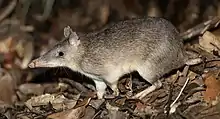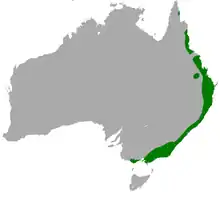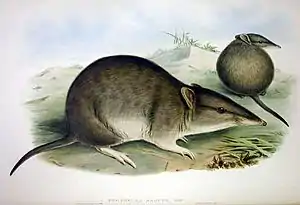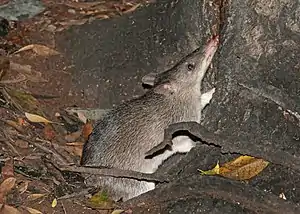Long-nosed bandicoot
The long-nosed bandicoot (Perameles nasuta) is a species of bandicoot found in eastern Australia, from north Queensland along the east coast to Victoria. Around 40 centimetres (16 in) long, it is sandy- or grey-brown with a long snouty nose. Omnivorous, it forages for invertebrates, fungi and plants at night.
| Long-nosed bandicoot[1] | |
|---|---|
 | |
| Scientific classification | |
| Kingdom: | Animalia |
| Phylum: | Chordata |
| Class: | Mammalia |
| Infraclass: | Marsupialia |
| Order: | Peramelemorphia |
| Family: | Peramelidae |
| Genus: | Perameles |
| Species: | P. nasuta |
| Binomial name | |
| Perameles nasuta Geoffroy, 1804 | |
 | |
| Long-nosed bandicoot range | |
| Synonyms | |
|
Perameles lawson Quoy & Gaimard, 1824 | |
Taxonomy

French naturalist Étienne Louis Geoffroy described the long-nosed bandicoot in 1804.[3] Swiss naturalist Heinrich Rudolf Schinz described a large specimen from near Bathurst in the Blue Mountains as a new species, Perameles lawson, in 1825, though the specimen was lost at sea in shipwreck.[4] French naturalist Pierre Boitard described Isoodon musei in 1841, both are now classified as P. nasuta.[5]
Two subspecies are recognised:[6] P. nasuta subspecies nasuta is found from western Victoria through eastern New South Wales and north to central Queensland, and P. nasuta subspecies pallescens, found from central Queensland through to the Cape York Peninsula.
The long-nosed bandicoot is the largest member of its genus, which also includes the eastern barred bandicoot and the western barred bandicoot.[7] It is most closely related to the eastern barred bandicoot, the two species having diverged from one another in the late Pliocene. Their ancestors diverged from the ancestor of the western barred bandicoot in the Miocene.[8]
Description

The long-nosed bandicoot is much less colourful than its relatives, being primarily a sandy-brown or greyish colour. It is nocturnal, non-climbing, solitary, and omnivorous. Its body length is around 40 centimetres (16 in), including a tail length of 14 centimetres (5.5 in), and it weighs 1.5 kilograms (3.3 lb). It has a very prominent long nose and small pointed upright ears, a hunched-looking posture, a short tail, a rear-facing pouch, and three long, clawed toes on front feet. The excreta are 3.5 centimetres (1.4 in) long by 1 centimetre (0.39 in) wide. The long-nosed bandicoot has a high-pitched squeak when disturbed.[9]
Distribution and habitat
The species is distributed along the eastern coast of Australia from Cape York Peninsula in Queensland to New South Wales and Victoria.[9] It is found in rainforest, moist gullies and grassy woodlands.[9]
Long-nosed bandicoots benefit from a mosaic of mixed habitats, including open grassy areas (such as lawns in urban areas) that they forage in at night-time and sheltered areas with undergrowth that they retreat to and nest in.[10]
Conservation
Widely distributed, it is classified as least concern on the IUCN Red List, with some localised decline in the southern part of its range.[2] Although faring better than many other native mammal species in the face of human impact, the long-nosed bandicoot vanished from much of Sydney in the 1960s. It is restricted to the outskirts such as the upper North Shore and Ku-ring-gai Chase National Park in the north, Blue Mountains in the west, Holsworthy in the southwest and Royal National Park in the south.[11] The species is a common visitor to gardens of people living near Garigal and Ku-ring-gai Chase National Parks and are generally well received.[12] Two small populations remain in the inner Sydney urban area: A population at North Head has been designated as endangered by the New South Wales government.[13] It is thought to number around 200 individuals. Sydney's Taronga Zoo is undertaking a breeding program to bolster the population.[14] A population centred around the urbanised suburb of Dulwich Hill in the Inner West was identified in 2002. Little remnant habitat exists and the numbers are thought to be low, though the bandicoots appear to have adapted to foraging in more urban habitat.[11] The population has been classified as endangered.[15]
Behaviour
Long-nosed bandicoots are solitary, individuals interacting little when not mating or parenting.[16]
Feeding
The long-nosed bandicoot is omnivorous and nocturnal, foraging for insects, such as beetles and beetle larvae (grubs), plants, including the roots of monocots, and fungi,[17] Invertebrates make up most of the diet year-round, with spiders, caterpillars, leaves and seeds more common food items in summer and cicada larvae, blades of grass, bracts (tiny true leaves) of wattles, and underground items such as roots and fungi eaten more in winter.[18] Long-nosed bandicoots spend much of their time digging,[16] and often leave characteristic conical holes in the ground where they have foraged looking for grubs in the soil.[11] It is often found near compost heaps.[9] The Long-nosed bandicoot is a host of the Acanthocephalan intestinal parasite Australiformis semoni.[19]
A field study in Booderee National Park showed that bandicoot numbers markedly increased following increase in invertebrate numbers before declining within two years.[20]
Predators
The long-nosed bandicoot is a common prey item of the introduced red fox. The greater sooty owl preys on bandicoots.[22]
Captivity
This bandicoot was first bred in captivity by Eleanor Stodart of the CSIRO in 1964. It appears to be straightforward to breed as long as ample space is supplied.[16]
References
- Groves, C.P. (2005). "Order Peramelemorphia". In Wilson, D.E.; Reeder, D.M (eds.). Mammal Species of the World: A Taxonomic and Geographic Reference (3rd ed.). Johns Hopkins University Press. p. 40. ISBN 978-0-8018-8221-0. OCLC 62265494.
- Lunney, D.; Dickman, C.; Menkhorst, P. (2008). "Perameles nasuta". IUCN Red List of Threatened Species. 2008: e.T40554A10333669. doi:10.2305/IUCN.UK.2008.RLTS.T40554A10333669.en.
- Geoffroy [Saint-Hilaire], Étienne (1804). "Mémoire sur un nouveau genre de mammifères à bourse, nommé Péramèles". Annales du Muséum National d'Histoire Naturelle. Paris (in French). 4: 56–64 [62–64].
- Quoy, J.R.C.; Gaimard, J.P. (1824). "Zoologie". In Freycinet, L.C.D. de (ed.). Voyage autour du Monde, entrepris par ordre du Roi, exécuté sur les corvettes de S.M. Uranie et la Physicienne, pendant les années 1817, 1818, 1819 et 1820. Paris: Pillet Aîné. pp. 57, 711.
- Australian Biological Resources Study (29 October 2010). "Subspecies Perameles nasuta nasuta Geoffroy, 1804". Australian Faunal Directory. Canberra, Australian Capital Territory: Department of the Environment, Water, Heritage and the Arts, Australian Government. Retrieved 7 April 2016.
- Australian Biological Resources Study (18 February 2011). "Names List for Perameles nasuta Geoffroy, 1804". Australian Faunal Directory. Canberra, Australian Capital Territory: Department of the Environment, Water, Heritage and the Arts, Australian Government. Retrieved 7 April 2016.
- Menkhorst, Peter (2001). A Field Guide to the Mammals of Australia. Oxford University Press. p. 78.
- Westerman, M; Krajewski, C (2000). "Molecular relationships of the Australian bandicoot genera Isoodon and Perameles (Marsupialia: Peramelina)". Australian Mammalogy. 22 (1): 1–8. doi:10.1071/AM00001.
- Wildlife of Tropical North Queensland. Queensland Museum Publication. (2000), p. 335.
- Chambers, Lisa K.; Dickman, Chris R. (2002). "Habitat selection of the long-nosed bandicoot, Perameles nasuta (Mammalia, Peramelidae), in a patchy urban environment". Austral Ecology. 27 (3): 334–42. doi:10.1046/j.1442-9993.2002.t01-1-01185.x.
- Leary, Tanya; Kwok, Alan; Khan, Ben; Ibbetson, Paul (2009). "Yuppie bandicoots of inner western Sydney–in hiding or urban renewal?." (PDF). In Daniel Lunney; Pat Hutchings; Dieter Hochuli (eds.). The Natural History of Sydney. Royal Zoological Society of New South Wales. pp. 415–25. ISBN 9780980327236.
- Dowle, Matthew; Deane, Elizabeth M. (2009). "Attitudes to native bandicoots in an urban environment". European Journal of Wildlife Research. 55 (1): 45–52. doi:10.1007/s10344-008-0212-9.
- Dickman, Chris (28 February 2011). "Long-nosed bandicoot population, North Head - endangered population listing: NSW Scientific Committee - final determination". Threatened species. Office of Environment and Heritage, New South Wales Government. Retrieved 11 April 2016.
- Taronga Conservation Society. "Long-nosed Bandicoot Breeding Program". Mosman, New South Wales: Taronga Zoo. Archived from the original on 14 April 2016. Retrieved 11 April 2016.
- Hughes , Lesley (28 February 2011). "Long-nosed Bandicoot Perameles nasuta Geoffroy, 1804 in inner western Sydney - endangered population listing: NSW Scientific Committee - final determination". Threatened species. Office of Environment and Heritage, New South Wales Government. Retrieved 11 April 2016.
- Stodart, Eleanor (1966). "Management and behaviour of breeding groups of the marsupial Perameles nasuta Geoffroy in captivity". Australian Journal of Zoology. 14 (4): 611–23. doi:10.1071/ZO9660611.
- Moyle, D. I.; Hume, I. D.; Hill, D. M. (1995). "Digestive performance and selective digesta retention in the long-nosed bandicoot, Perameles nasuta, a small omnivorous marsupial". Journal of Comparative Physiology B. 164 (7): 552–60. doi:10.1007/BF00261396.
- Thums, Michele; Klaassen, Marcel; Hume, Ian D. (2005). "Seasonal changes in the diet of the long-nosed bandicoot (Perameles nasuta) assessed by analysis of faecal scats and of stable isotopes in blood". Australian Journal of Zoology. 53 (2): 87–93. doi:10.1071/ZO04030.
- Schmidt, Gerald D.; Edmonds, Stanley J. (1989). "Australiformis semoni (Linstow, 1898) n. Gen., n. Comb. (Acanthocephala: Moniliformidae) from Marsupials of Australia and New Guinea". The Journal of Parasitology. 75 (2): 215–7. doi:10.2307/3282769. JSTOR 3282769. PMID 2926590.
- Dexter, Nick; Hudson, Matt; Carter, Tony; Macgregor, Christopher (2011). "Habitat‐dependent population regulation in an irrupting population of long‐nosed bandicoots ( Perameles nasuta)". Austral Ecology. 36 (7): 745–54. doi:10.1111/j.1442-9993.2010.02213.x.
- Australian Museum (27 January 2016). "Long-nosed Bandicoot". Retrieved 27 April 2016.
- Bilney, Rohan; Cooke, Raylene; White, John (2006). "Change in the diet of sooty owls (Tyto tenebricosa) since European settlement: from terrestrial to arboreal prey and increased overlap with powerful owls". Wildlife Research. 33 (1): 17–24. doi:10.1071/WR04128. hdl:10536/DRO/DU:30003762.
External links
| Wikimedia Commons has media related to Perameles nasuta. |
| Wikispecies has information related to Perameles nasuta. |
